ISSN ONLINE(2319-8753)PRINT(2347-6710)
ISSN ONLINE(2319-8753)PRINT(2347-6710)
S.Srinivasa Ragavan1, Dr.A.Siva Kumar2 , N.Prabhu Kishore3 & Dr.K.Vijaya Kumar Reddy4
|
| Related article at Pubmed, Scholar Google |
Visit for more related articles at International Journal of Innovative Research in Science, Engineering and Technology
The increase in fatalities day by day due to vehicle crash is a great challenge for automobile industry. There are lots of safety enabled features has been developed such as seatbelts and airbags, which reduces the occupant injury in considerable amount. But the recent studies and statistics are showing that there is lots of fatalities are reported due to impact on interior components of automobile. To address this situation and to reduce the occupant injuries due to impact on interior components NHTSA designed new safety protocol FMVSS 201 to evaluate the head impact on interior parts. To meet these new protocol by maintain good design integration of parts requires certain procedures, which can be used by automobile manufacturers for designing safer vehicle. An attempt is made to study and analyze the head impact on upper roof of an automobile and come up with different design suggestions. The impact situation is evaluated by using head impact criterion of dummy. These attempts will be helpful to reduce the injury and also numerous design iterations can be reduced. This in turn reduces the total development time of an automobile.
Keywords |
| Occupant injuries, interior parts, NHTSA, upper roof, HIC (d), FMVSS 201, head impact design iterations, development time. |
INTRODUCTION |
| In today’s automotive world providing safety to occupants is biggest challenge for car manufacturers. Development of safety features like airbags, seat belts, antilock braking system reduced the fatalities. But in recent survey conducted by national highway traffic safety administration saying that head impact on interior parts of automobile is accounting lots of severe injuries to the occupants. To reduce the occupant injuries during this situation NHTSA established new safety regulation FMVSS 201, which focuses mainly on head impact on interior parts of the automobile[1]. Automobile manufactures has to satisfy this regulation which includes head impact protection on interior parts such as A-pillar, roof, side rails, B-Pillar, to satisfy this regulation requires certain procedures and methodology. National Highway traffic administration has established various target points where impact has to be evaluated. To evaluate the head injury the exact head model representing the human head is required. This is well represented by bio fidelity. Bio fidelity is defined as the quality of being life like in appearance and often referred to dummies used in safety investigation. Free motion head form known as FMH having exact behaviour as of human head in bio fidelity testing is NHTSA recognized test device. |
| Head impact injury is calculated by using the mathematical expression head impact criterion (HIC). HIC is resultant acceleration of FMH and two time limits in acceleration curve for which maximum value of HIC is determined. HIC has to be converted to HIC (d) dummy equivalent value [2]. |
 |
| The acceleration and hic value of FMH is influenced by the impact velocity and behaviour of body in white (BIW). The NHTSA specified impact velocity for FMH is 12 mph or 15 mph based on target location. Many manufactures now days are providing side airbags for injury reduction, if the target area is within the airbag covering area the impact velocity is 12 mph in remaining locations impact velocity is 15 mph. The target value for HIC (d) specified by NHTSA is 1000. HIC value should not exceed 1000. |
| To achieve the lesser HIC value, the effect of different counter measures should be known. This creates a need to perform effect study which can be used to evaluate various design suggestions in order to reduce the HIC value. The CAE tools used for our present investigation are pre processing on HYPERMESH. Altair Hyper Mesh is a highperformance finite element pre-processor that provides a highly interactive and visual environment to analyze product design performance. Solving is done in LS-DYNA is a multifunctional applicable explicit and implicit Finite-Element program to simulate and analyze highly nonlinear physical phenomenon's obtained in real world problems[3-6]. Post processing done on HYPER VIEW. |
II. MODEL BUILD |
A. FREE MOTION HEADFORM |
| Free motion head form (FMH) is the head model of a Hybrid III dummy which is recognized by NHTSA for evaluating head impact protection against vehicle interior components. The nose and other features of the hybrid III dummy head are removed to prevent their interference with the trim component during testing. Physical model of free motion head form (FMH) mainly consists of an outer rubber skin attached firmly over an inner aluminium skull. At the centre of gravity of FMH, accelerometers are placed to record the acceleration used to calculate the HIC (d). To accurately simulate the behaviour of FMH using the finite element method, the following key features need to be incorporated |
| A finite element model of a featureless FMH developed by a commercial software vender is used in this research. The following figure shows an isometric view of the model indicating the impact zone as defined by NHTSA. It can be observed form the figure that the impact zone on FMH has been finely discretized as shown in fig.1. This is done to improve the contact force distribution thus providing smoother acceleration responses. |
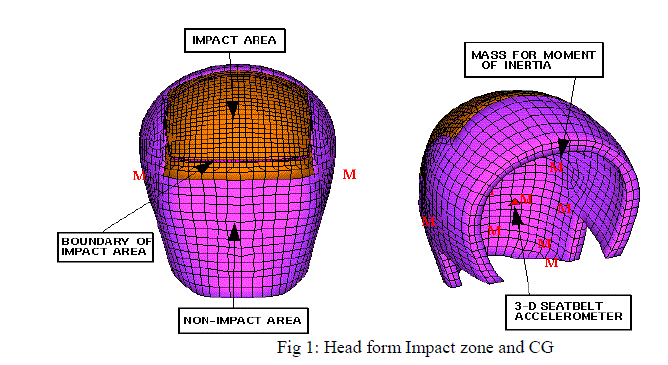 |
B. BODY IN WHITE &TRIM |
| The body in white (BIW) and trim components are modeled with shell element (*ELEMENT_SHELL) with default element formulation available in LSDYNA as per the geometry. The shell element formulation is based on Belytschko-Lin-Tsay formulation with reduced integration available in LSDYNA. This element is generally considered as computationally efficient and accurate. FE model size is 8 mm average and 5 mm as minimum length for BIW and for trim element size is 5mm average and 2mm minimum as per Fig.2&3. Quality of the elements are checked and fixed as per the standard. In all mounting holes 4 or 6 nodes are maintained for connections. |
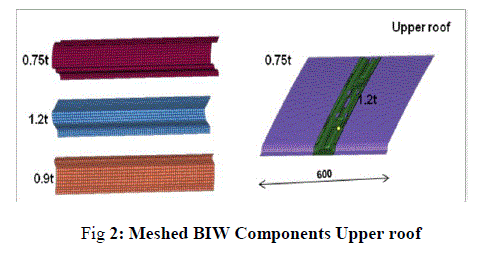 |
C. SECTION AND MATERIAL PROPERTY |
| Required thickness is assigned using *SECTION_SHELL card as shown in figure. BIW Components are assigned with steel and trim components are assigned with PP as per Fig.4. |
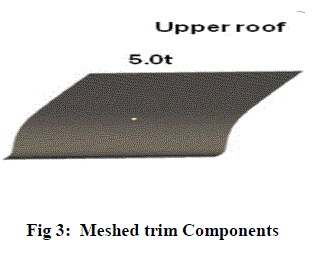 |
D. EFFECT STUDY |
| The head liner with different cases has been analyzed the various cases which are considered for this effect study are without headliner, with counter measure ribs of different thickness, counter measure foam and different impact angles for head form. The cut section view of this model is shown below as per Fig.5. |
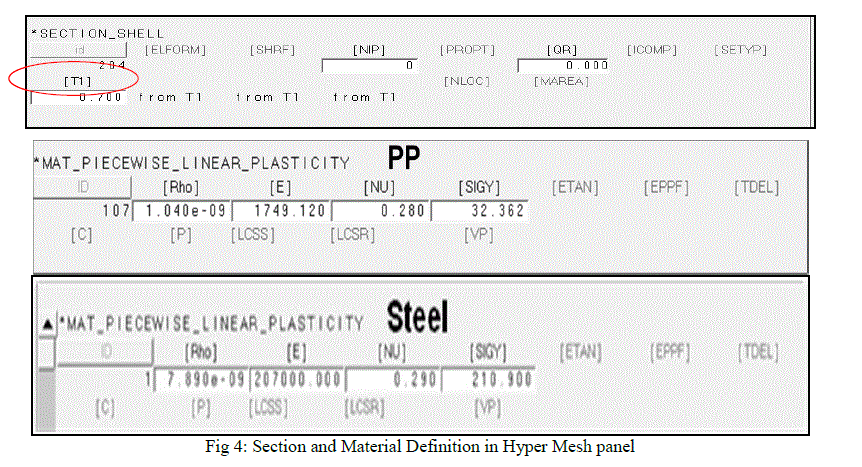 |
E. CONTACT DEFINITION |
| *CONTACT_AUTOMATIC_SURFACE_TO_SURFACE card is defined between Head form (Master) and Trim/BIW (Slave) with friction value of 0.25 both static and dynamic.*CONTACT_AUTOMATIC_SURFACE card is defined for all component with friction value of 0.25For better contact between trim and BIW *CONTACT_AUTOMATIC_SURFACE card is defined with friction value of 0.25 as per Fig.6. |
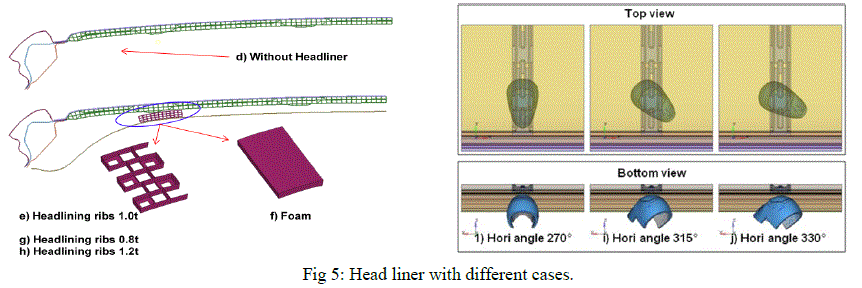 |
F. INITIAL VELOCITY AND BOUNDARY CONDITIONS |
| *INITIAL_VELOCITY_NODE card is given to head form for defining the initial velocity. 15mph (6705 mmps) is given to head form as per the FMVSS 201 impact conditions For realistic behavior of Upper roof, Symmetry conditions i.e.2, 4, 6 (TY, RX, RZ) and fixed conditions i.e. 1, 2, 3 (TX, TY, TZ) are given.*BOUNDARY_SPC_NODE card is used to define the constraints as per Fig.7&8. |
 |
G. CONTROL AND DATABASE CARD |
| Control cards are used to change the defaults and activate solutions options such as mass scaling. Following two cards are used for termination time and mass scaling as per Fig.9&10. |
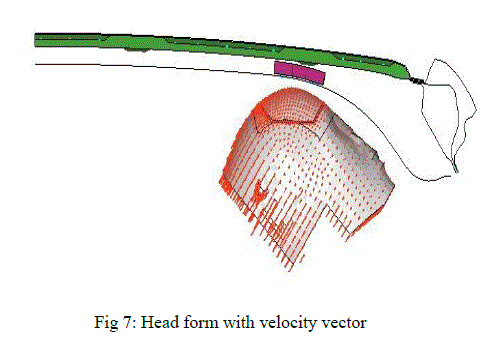 |
| Database cards are used to obtain output files containing results information. Two cards are used database binary d3plot and database option – glstat, matsum, node out. |
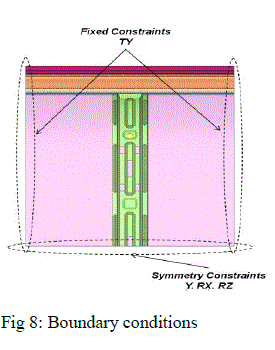 |
III. RESULTS AND DISCUSSION |
| Results and discussions are predominantly analysed in the following order: |
| ïÃÆÃË Base file headliner 1 design without counter measures |
| ïÃÆÃË Comparison of Headliner designs |
A. Base file headliner 1 design with no counter measures |
| In the upper roof a target point with 270 degree horizontal angle and 50 degree vertical angle is impact with the velocity of 15 mph. The energy balance and acceleration plot are shown below. The global energy is smooth and continuous. The Kinetic Energy is equal to the total energy initially and it is decreasing to the value eventually begin to increase as the head form rebounds in the opposite direction. The Internal Energy is zero initially and it increase and eventually decrease and resembles a mirror image of the Kinetic Energy curve. All other energies are below 5 % of the total energy as per Fig.11&12. |
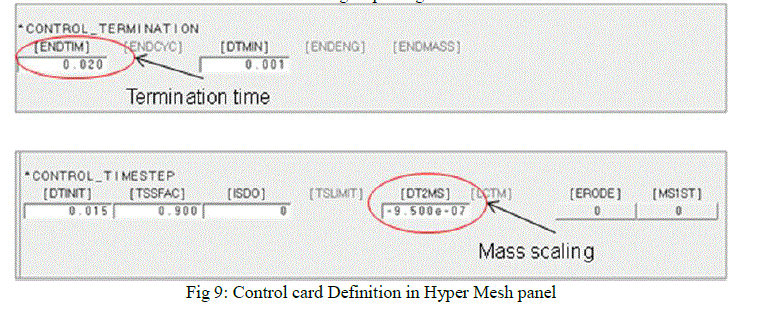 |
| In this model there is no counter measure between headliner and BIW. Target point with no counter measure produced a HIC (d) value of 518. In the resultant acceleration plot shown in fig 12, maximum time duration of around 2.5ms was achieved before the FMH impacted the headliner. |
| At 4ms there is first peak acceleration of 85 g’s which is maintained for 6 ms results in HIC (d) value of 518. Second peak acceleration of 55 g’s at 16 ms where as per Fig.13. |
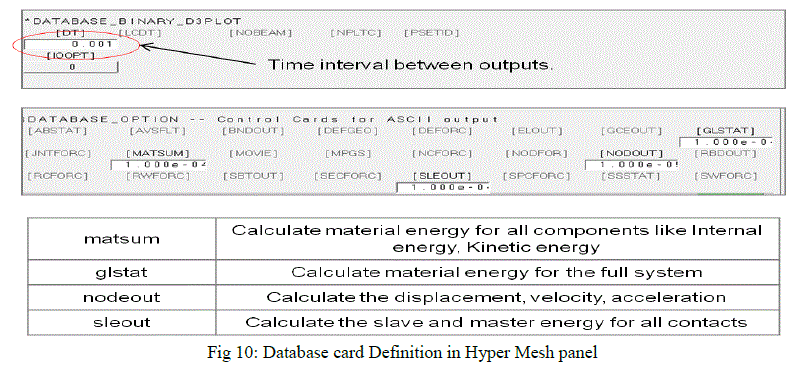 |
| Head form chin is impacting the headliner where undergoes rotation this lead to reduce in HIC (d) value. The trend of upper roof case will have two peak accelerations. |
B. Comparison of headliner designs |
| The HIC (d) value of the 3 Headliner design are 518, 570 & 534. The first peak acceleration of headliner 2 is same as base whereas the headliner 3 is 72 g’s which is less than base. The second peak acceleration of headliner 2 & headliner 3 are higher than base 105 g’s & 100 g’s respectively as per Fig.14,15&16. |
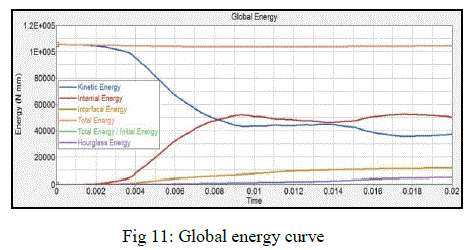 |
| Each headliner design is checked for offset above and below as shown in the below fig18. HIC (d) values are shown in the table. From this table it is clear that then the headliner is near the BIW the HIC (d) is high and it is low when headliner is away from the BIW. In the acceleration plot there is only time lag between these 3 cases and peak acceleration difference is same between two cases. The gap between the BIW and trim should be in the range between 30 to 40 mm. |
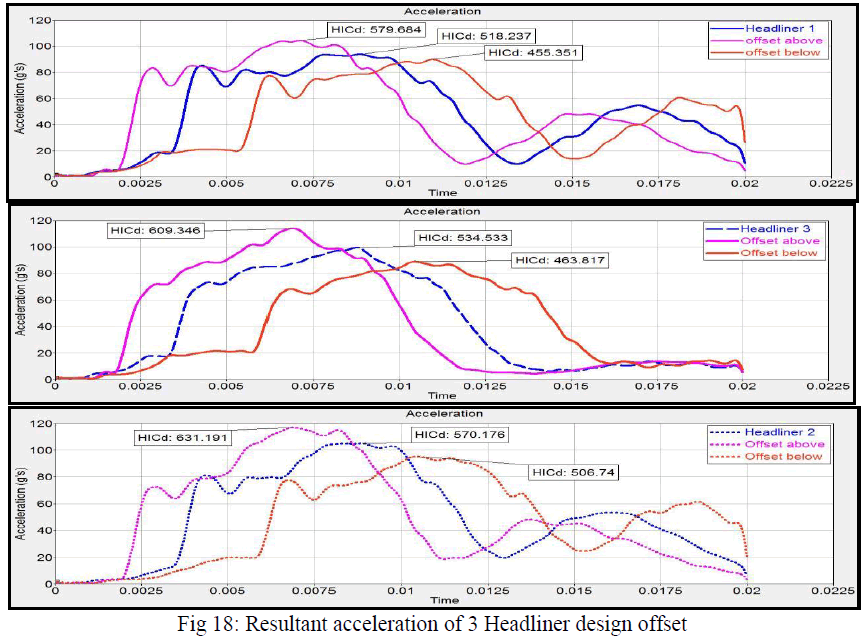 |
IV. CONCLUSION |
| The following conclusions are drawn from the various finite element analyses performed in this Project.Head form should be designed by mapping with normal angles, where in impractical conditions can be taken care. The optimum stopping distance between headliner and BIW is 30 to 40 mm. |
References |
|